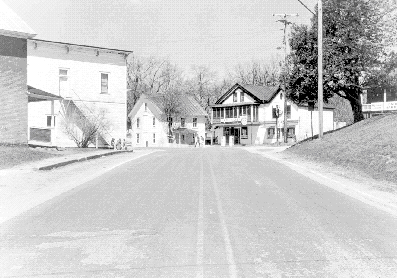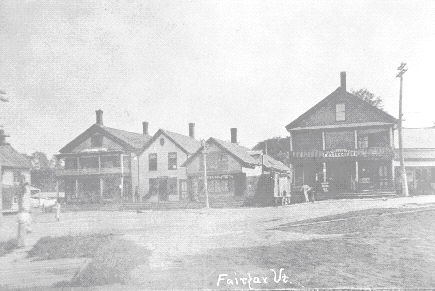

The Local Economy
Although employment in agriculture is slowly declining with mechanization and the consolidation of the small family farms into larger units, the agrarian economy is and should be a vitally important portion of the town's present and future economic growth. The town has a number of retail businesses serving the basic needs of villagers and the surrounding countryside. These include several business located in the mini-mall on the east side of town. Future commercial development will likely be in the service sector and in retail businesses located in the mixed use growth center in and around the existing village. Small wholesale businesses and a Milton Bradley factory are Morse Lumber are also located in town. Home businesses and industries also account for a growing part of the local economy.
The strength and stability of the agricultural economic base should be promoted. Agribusiness and other support and co-operative services should be encouraged to locate in the town. A diverse economic base is, on the whole, more resistant to adverse changes and thus home occupations and other small industries and businesses should be encouraged as well. However, measures should be taken to ensure that any industrial and commercial development that does occur is compatible with the town's rural character. Enterprises that use the skills of the local labor force are desired.
There are no large-scale potential commercial sites in Fairfax with easy access to the interstate highway system. Turnkey commercial sites are available in three neighboring towns and the likelihood of a major employer locating in Fairfax is limited. Fairfax is more likely to has been and is likely to continue to experience residential and perhaps small scale commercial growth (without a significant increase in the property tax base) were in response to a major employer to locating or expanding in an adjacent community.
Recent developments in State law have the potential to fundamentally change the way in which small communities approach the development of the local economy. Act 60, which provides for statewide property tax sharing to provide educational funding, has impacts reaching far beyond the realm of education. For decades, many small communities have sought to attract commercial and industrial development in the interest of broadening the local tax base. Often this type of development has occurred in ways that may not be compatible (in scale or in need) with the local community.
Although the future of the controversial Act 60 is uncertain, the prognosis is positive for continued statewide property tax sharing in some form for many years to come. If property tax sharing in Vermont becomes the "new paradigm", communities will have a greater chance of developing commerce and industry which is best suited to the size, character, and regional economic importance of the community, without suffering adverse economic consequences.
In this way, larger scale commercial and industrial development could be concentrated in regional centers, where necessary infrastructure is available.
Property tax sharing would help communities such as Fairfax to focus on smaller scale commercial and industrial development appropriate to its role as a sub-regional economic center.
_____________________________________________
Local Economy Goals, Objectives, and Policies
Goal
Objectives
Policies

Housing
Existing Conditions
Fairfax is has increasingly become a bedroom community for residents who work in the Burlington and St. Albans areas. This is due to its accessibility from Routes 104 and I-89, as well as the shortage and cost of housing closer to these employment centers. Undoubtedly, the aesthetic attractiveness of the town also contributes to this trend.
The 2002 Grand List reflects 1,235 housing units, up from the 1995 (November) Grand List which showed 914 housing units in Fairfax. By April of 1997, this figure had grown to 980 units. The majority (63 64%) are single family homes on less than 6 acres of land. These "R-1" properties represent nearly half of the total listed value on the 1997 2002 Grand List. Residential properties account for the overwhelming majority of the Town's tax base, with 81%, up slightly from 78%, of the Town's total listed value, in 1997. Both the total value and number of properties have increased for R-1 parcels since 1995. R-2, or multi-family residential properties, have also increased as a percentage of the total listed value.
Commercial rental properties comprise less than 1% of the total Grand List. Similarly, vacation and seasonal housing contributes only .24% of the total Grand List. These data are shown in Table 1.
Single-family residential property owners in Fairfax, on average, pay the highest R-1 annual tax of any community in Franklin County. This is due in part to the high average fair market value for R-1 properties in Fairfax, which are second only to Georgia in average value.
Overall, the housing is in sound condition. There are some very beautiful old homes in Fairfax, which the town historical society has recognized as having significance, and are listed in the Vermont Division for Historic Preservation, Historic Sites and Structures Survey.
Affordable Housing
Safe, adequate housing is inarguably one of our most basic needs. It is an important planning consideration to ensure that being able to afford adequate housing is not the luxury of a select few. Instead, a variety of housing types (in equally various price ranges) needs to be aggressively promoted to foster a diverse community which is not economically exclusive. Housing which is affordable for first-time buyers, senior citizens (often on fixed incomes), and for lower income residents is especially important in this regard.Rental housing in Fairfax is at a premium. Of the 57 27 vacant housing units identified by the 2000 Census, only 5 6 were available for rent; less than half the vacancies in 1990 (57). This very low vacancy rate for rental properties has a tendency to drive up rental costs, making housing less affordable. Median gross rent in 1990 2000 was $655 473 per month in Fairfax, considerably higher than the $539 412 figure for Franklin County; up from $473 and $412 in 1990 respectively. Median Monthly Owner Costs in 2000 was $1,120 per month; slightly higher than in Franklin County ($948). Although per capita, family, and household income is greater in Fairfax than for the rest of the County, an income disparity exists between renters and homeowners. As illustrated in Figure 3, household income for renters is dramatically lower than for homeowners, with less than 20% of all renters having household incomes of greater than $35,000.
It follows from the above that a disproportionate number Of Fairfax residents, 18.5% of owners and 32.7% of renters are "rent burdened", defined as paying greater than 30% of their income on rent and utilities or a mortgage. Although this group is still too large, this is a marked improvement from 1990 trends, where 74% of all households were spending more than 30% on housing. Fairfax is no exception, in Franklin County 22.2% of owners and 31.5% of renters are experiencing the same financial obstacles. Sample Census data show that of all renters with household incomes of less than $10,000, 58.3% were rent burdened. For households with incomes between $10,000 and $20,000, the statistics are even more severe, with 73.9% of all households being rent burdened. Additionally, 24.2% of households with $20,000 to $35,000 incomes paid more than 30% of household income on housing costs.
This information indicates that the Median Owner Household Income is $58,690, while the Median Renter Household Income is $31,440.
Fairfax has one senior housing complex with 12 20 housing units, and proposals for 47 additional units. This housing, originally constructed solely for seniors using Federal funds, is now subject to new guidelines governing applicant eligibility for these units. Under current guidelines, The existing units may be made available to any applicant whose income meets the "very low" status needed to qualify. Applicants need not be from Fairfax to qualify.
These amended guidelines provide opportunities for very low income residents to secure adequate housing in the Town, and as such serve a very important function. A potential drawback is that the units no longer serve Fairfax as a means of providing solely for older community members to stay in the town after they are no longer able to maintain their own homes. The construction of additional senior housing would better serve the older population of Fairfax, who account for nearly one fifth 4% of all residents below the poverty line. The establishment of a trust or housing cooperative, or collaboration with any of the local organizations specializing in this type of development and management could be investigated to address this problem.
The primary source for affordable housing mortgages has been the VHFA (Vermont Housing Finance Authority.) It offers low down payment, low interest mortgages for couples with incomes no higher than $39,500 $65,600. A few mortgages have been available for first-time buyers with no down payment. The present maximum housing price is $97,000 $170,000 for existing homes and $220,000 for new construction, normally with a down payment of 5%. In recent years commercial banks have responded to the need and established "first-step" mortgages. For some banks the income levels for these mortgages can be $45,000 for a single buyer and $55,000 for a couple (or two or more buyers). Again a 5% down payment is required. Some banks do not have a cap on the housing price; it depends upon the circumstances of the buyers. Other banks cap the price at $125,000. ) Of the residential properties on the 1995 grand list, approximately 25 percent are listed at equal or less than $97,000 and 75 percent at $125,000 or less.

Fairfax's zoning regulations allow for a diversity of housing types, regardless of housing cost or type, residents or income. do not screen out inexpensive homes or consign them to special locations, nor are there any impact fees. There are no restrictions on mobile or modular homes.
Construction of new housing in existing centers is inherently more affordable; most particularly, where municipal services, such as municipal water and sewer, are provided. Proximity to services, smaller lot sizes, and less costly road construction help keep construction and maintenance costs at a minimum. These savings can then be passed on to the buyer or renter. Utilizing small, in-town lots for infill development, and rehabilitating existing structures can also help create housing which is "naturally" more affordable. Currently, in the village area of Fairfax - where municipal infrastructure exists - has little excess the adequacy of the sewerage capacity is in question. and It is suspected to be in need of major improvements or expansion. to its water distribution system. The potential for future growth in this area - at higher densities than in other parts of town – has been hamstrung by these inadequacies will be dependent on the availability of infrastructure, as discussed earlier. Integrated planning for both public service improvements and affordable housing is of paramount importance for Fairfax's immediate future.
_____________________________________________
Housing Goals, Objectives, and Policies
Goals
Objectives
Policies

|

|

|